Xiong Zhou
Variation-Bounded Loss for Noise-Tolerant Learning
Nov 15, 2025Abstract:Mitigating the negative impact of noisy labels has been aperennial issue in supervised learning. Robust loss functions have emerged as a prevalent solution to this problem. In this work, we introduce the Variation Ratio as a novel property related to the robustness of loss functions, and propose a new family of robust loss functions, termed Variation-Bounded Loss (VBL), which is characterized by a bounded variation ratio. We provide theoretical analyses of the variation ratio, proving that a smaller variation ratio would lead to better robustness. Furthermore, we reveal that the variation ratio provides a feasible method to relax the symmetric condition and offers a more concise path to achieve the asymmetric condition. Based on the variation ratio, we reformulate several commonly used loss functions into a variation-bounded form for practical applications. Positive experiments on various datasets exhibit the effectiveness and flexibility of our approach.
Joint Asymmetric Loss for Learning with Noisy Labels
Jul 23, 2025Abstract:Learning with noisy labels is a crucial task for training accurate deep neural networks. To mitigate label noise, prior studies have proposed various robust loss functions, particularly symmetric losses. Nevertheless, symmetric losses usually suffer from the underfitting issue due to the overly strict constraint. To address this problem, the Active Passive Loss (APL) jointly optimizes an active and a passive loss to mutually enhance the overall fitting ability. Within APL, symmetric losses have been successfully extended, yielding advanced robust loss functions. Despite these advancements, emerging theoretical analyses indicate that asymmetric losses, a new class of robust loss functions, possess superior properties compared to symmetric losses. However, existing asymmetric losses are not compatible with advanced optimization frameworks such as APL, limiting their potential and applicability. Motivated by this theoretical gap and the prospect of asymmetric losses, we extend the asymmetric loss to the more complex passive loss scenario and propose the Asymetric Mean Square Error (AMSE), a novel asymmetric loss. We rigorously establish the necessary and sufficient condition under which AMSE satisfies the asymmetric condition. By substituting the traditional symmetric passive loss in APL with our proposed AMSE, we introduce a novel robust loss framework termed Joint Asymmetric Loss (JAL). Extensive experiments demonstrate the effectiveness of our method in mitigating label noise. Code available at: https://github.com/cswjl/joint-asymmetric-loss
Proposer-Agent-Evaluator(PAE): Autonomous Skill Discovery For Foundation Model Internet Agents
Dec 17, 2024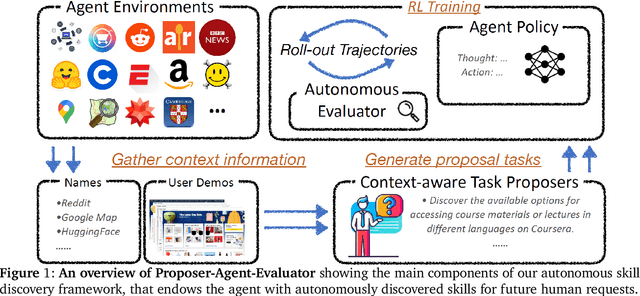
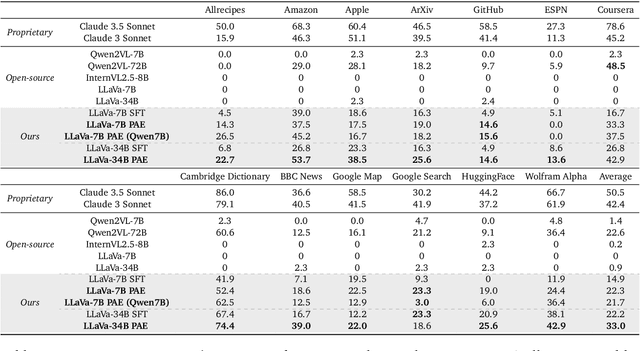
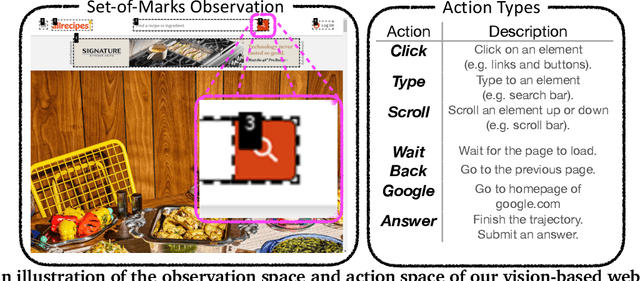
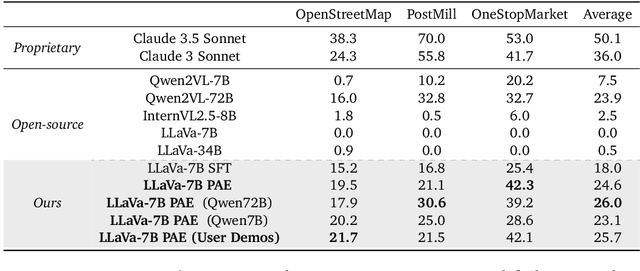
Abstract:The vision of a broadly capable and goal-directed agent, such as an Internet-browsing agent in the digital world and a household humanoid in the physical world, has rapidly advanced, thanks to the generalization capability of foundation models. Such a generalist agent needs to have a large and diverse skill repertoire, such as finding directions between two travel locations and buying specific items from the Internet. If each skill needs to be specified manually through a fixed set of human-annotated instructions, the agent's skill repertoire will necessarily be limited due to the quantity and diversity of human-annotated instructions. In this work, we address this challenge by proposing Proposer-Agent-Evaluator, an effective learning system that enables foundation model agents to autonomously discover and practice skills in the wild. At the heart of PAE is a context-aware task proposer that autonomously proposes tasks for the agent to practice with context information of the environment such as user demos or even just the name of the website itself for Internet-browsing agents. Then, the agent policy attempts those tasks with thoughts and actual grounded operations in the real world with resulting trajectories evaluated by an autonomous VLM-based success evaluator. The success evaluation serves as the reward signal for the agent to refine its policies through RL. We validate PAE on challenging vision-based web navigation, using both real-world and self-hosted websites from WebVoyager and WebArena.To the best of our knowledge, this work represents the first effective learning system to apply autonomous task proposal with RL for agents that generalizes real-world human-annotated benchmarks with SOTA performances. Our open-source checkpoints and code can be found in https://yanqval.github.io/PAE/
Neural Field Classifiers via Target Encoding and Classification Loss
Mar 02, 2024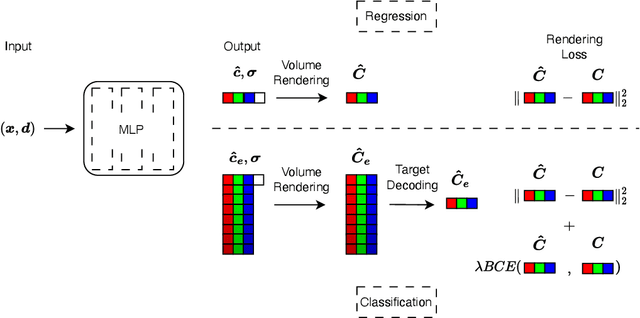
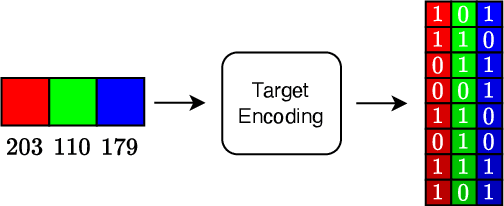
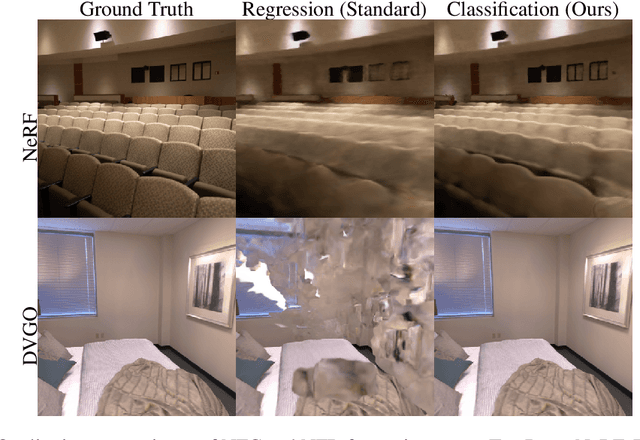
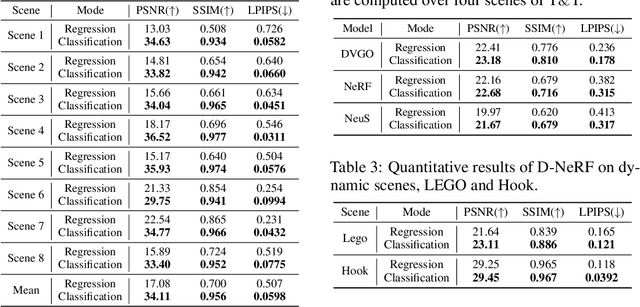
Abstract:Neural field methods have seen great progress in various long-standing tasks in computer vision and computer graphics, including novel view synthesis and geometry reconstruction. As existing neural field methods try to predict some coordinate-based continuous target values, such as RGB for Neural Radiance Field (NeRF), all of these methods are regression models and are optimized by some regression loss. However, are regression models really better than classification models for neural field methods? In this work, we try to visit this very fundamental but overlooked question for neural fields from a machine learning perspective. We successfully propose a novel Neural Field Classifier (NFC) framework which formulates existing neural field methods as classification tasks rather than regression tasks. The proposed NFC can easily transform arbitrary Neural Field Regressor (NFR) into its classification variant via employing a novel Target Encoding module and optimizing a classification loss. By encoding a continuous regression target into a high-dimensional discrete encoding, we naturally formulate a multi-label classification task. Extensive experiments demonstrate the impressive effectiveness of NFC at the nearly free extra computational costs. Moreover, NFC also shows robustness to sparse inputs, corrupted images, and dynamic scenes.
ViGoR: Improving Visual Grounding of Large Vision Language Models with Fine-Grained Reward Modeling
Feb 09, 2024



Abstract:By combining natural language understanding and the generation capabilities and breadth of knowledge of large language models with image perception, recent large vision language models (LVLMs) have shown unprecedented reasoning capabilities in the real world. However, the generated text often suffers from inaccurate grounding in the visual input, resulting in errors such as hallucinating nonexistent scene elements, missing significant parts of the scene, and inferring incorrect attributes and relationships between objects. To address these issues, we introduce a novel framework, ViGoR (Visual Grounding Through Fine-Grained Reward Modeling) that utilizes fine-grained reward modeling to significantly enhance the visual grounding of LVLMs over pre-trained baselines. This improvement is efficiently achieved using much cheaper human evaluations instead of full supervisions, as well as automated methods. We show the effectiveness of our approach through numerous metrics on several benchmarks. Additionally, we construct a comprehensive and challenging dataset specifically designed to validate the visual grounding capabilities of LVLMs. Finally, we plan to release our human annotation comprising approximately 16,000 images and generated text pairs with fine-grained evaluations to contribute to related research in the community.
AffordanceLLM: Grounding Affordance from Vision Language Models
Jan 12, 2024



Abstract:Affordance grounding refers to the task of finding the area of an object with which one can interact. It is a fundamental but challenging task, as a successful solution requires the comprehensive understanding of a scene in multiple aspects including detection, localization, and recognition of objects with their parts, of geo-spatial configuration/layout of the scene, of 3D shapes and physics, as well as of the functionality and potential interaction of the objects and humans. Much of the knowledge is hidden and beyond the image content with the supervised labels from a limited training set. In this paper, we make an attempt to improve the generalization capability of the current affordance grounding by taking the advantage of the rich world, abstract, and human-object-interaction knowledge from pretrained large-scale vision language models. Under the AGD20K benchmark, our proposed model demonstrates a significant performance gain over the competing methods for in-the-wild object affordance grounding. We further demonstrate it can ground affordance for objects from random Internet images, even if both objects and actions are unseen during training. Project site: https://jasonqsy.github.io/AffordanceLLM/
On the Dynamics Under the Unhinged Loss and Beyond
Dec 13, 2023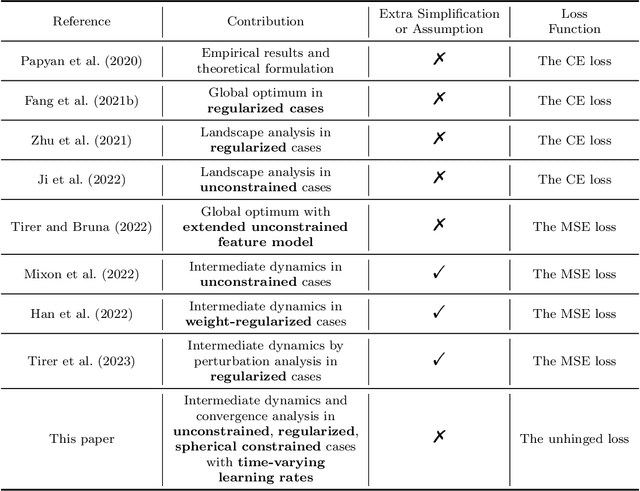



Abstract:Recent works have studied implicit biases in deep learning, especially the behavior of last-layer features and classifier weights. However, they usually need to simplify the intermediate dynamics under gradient flow or gradient descent due to the intractability of loss functions and model architectures. In this paper, we introduce the unhinged loss, a concise loss function, that offers more mathematical opportunities to analyze the closed-form dynamics while requiring as few simplifications or assumptions as possible. The unhinged loss allows for considering more practical techniques, such as time-vary learning rates and feature normalization. Based on the layer-peeled model that views last-layer features as free optimization variables, we conduct a thorough analysis in the unconstrained, regularized, and spherical constrained cases, as well as the case where the neural tangent kernel remains invariant. To bridge the performance of the unhinged loss to that of Cross-Entropy (CE), we investigate the scenario of fixing classifier weights with a specific structure, (e.g., a simplex equiangular tight frame). Our analysis shows that these dynamics converge exponentially fast to a solution depending on the initialization of features and classifier weights. These theoretical results not only offer valuable insights, including explicit feature regularization and rescaled learning rates for enhancing practical training with the unhinged loss, but also extend their applicability to other loss functions. Finally, we empirically demonstrate these theoretical results and insights through extensive experiments.
Visual Prompt Tuning for Test-time Domain Adaptation
Oct 10, 2022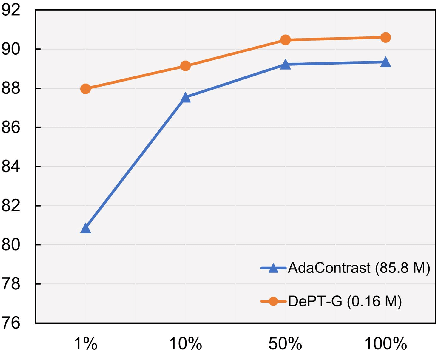
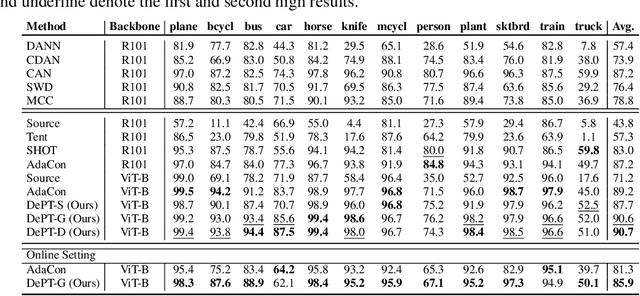
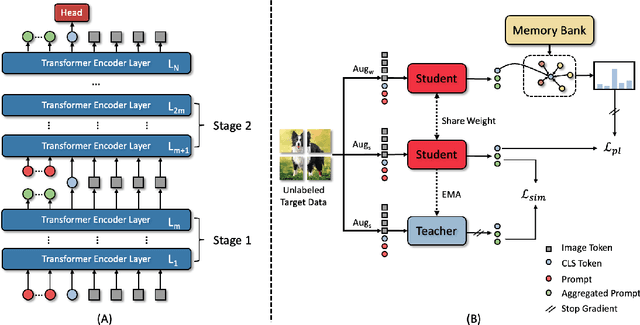
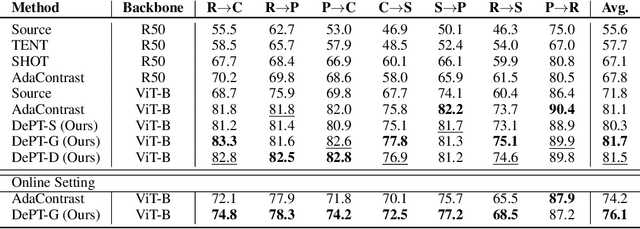
Abstract:Models should have the ability to adapt to unseen data during test-time to avoid performance drop caused by inevitable distribution shifts in real-world deployment scenarios. In this work, we tackle the practical yet challenging test-time adaptation (TTA) problem, where a model adapts to the target domain without accessing the source data. We propose a simple recipe called data-efficient prompt tuning (DePT) with two key ingredients. First, DePT plugs visual prompts into the vision Transformer and only tunes these source-initialized prompts during adaptation. We find such parameter-efficient finetuning can efficiently adapt the model representation to the target domain without overfitting to the noise in the learning objective. Second, DePT bootstraps the source representation to the target domain by memory bank-based online pseudo labeling. A hierarchical self-supervised regularization specially designed for prompts is jointly optimized to alleviate error accumulation during self-training. With much fewer tunable parameters, DePT demonstrates not only state-of-the-art performance on major adaptation benchmarks, but also superior data efficiency, i.e., adaptation with only 1\% or 10\% data without much performance degradation compared to 100\% data. In addition, DePT is also versatile to be extended to online or multi-source TTA settings.
Prototype-Anchored Learning for Learning with Imperfect Annotations
Jun 23, 2022
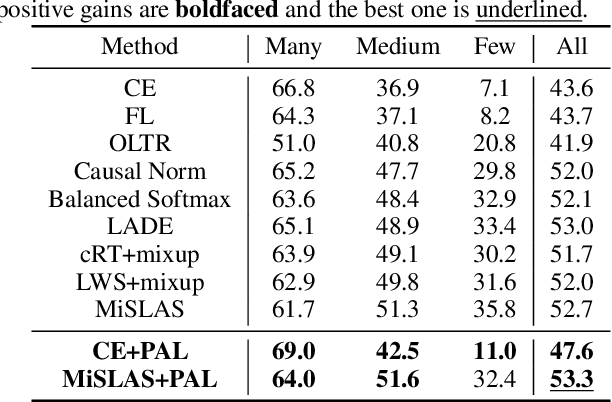

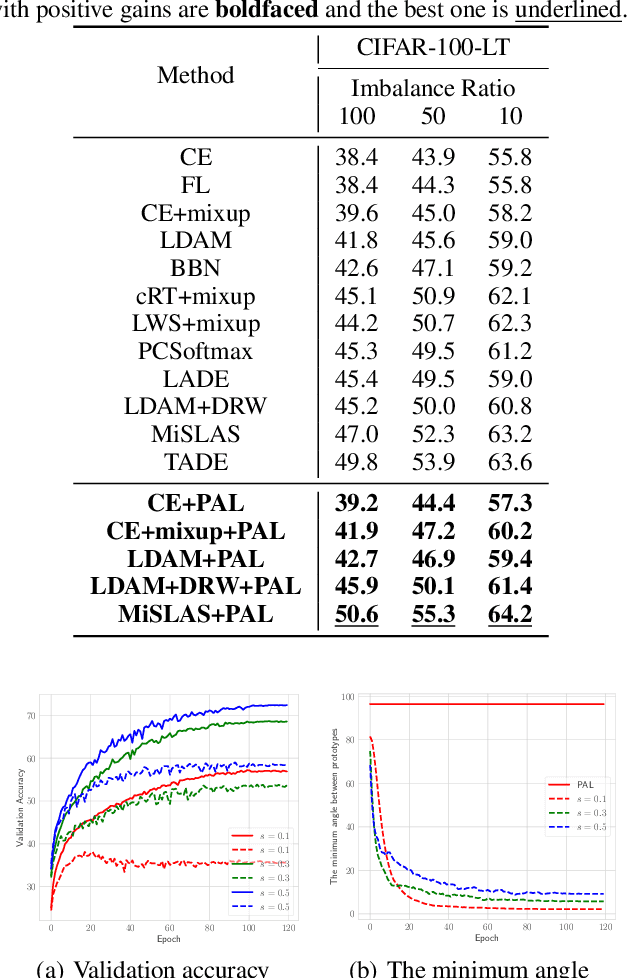
Abstract:The success of deep neural networks greatly relies on the availability of large amounts of high-quality annotated data, which however are difficult or expensive to obtain. The resulting labels may be class imbalanced, noisy or human biased. It is challenging to learn unbiased classification models from imperfectly annotated datasets, on which we usually suffer from overfitting or underfitting. In this work, we thoroughly investigate the popular softmax loss and margin-based loss, and offer a feasible approach to tighten the generalization error bound by maximizing the minimal sample margin. We further derive the optimality condition for this purpose, which indicates how the class prototypes should be anchored. Motivated by theoretical analysis, we propose a simple yet effective method, namely prototype-anchored learning (PAL), which can be easily incorporated into various learning-based classification schemes to handle imperfect annotation. We verify the effectiveness of PAL on class-imbalanced learning and noise-tolerant learning by extensive experiments on synthetic and real-world datasets.
Learning Towards the Largest Margins
Jun 23, 2022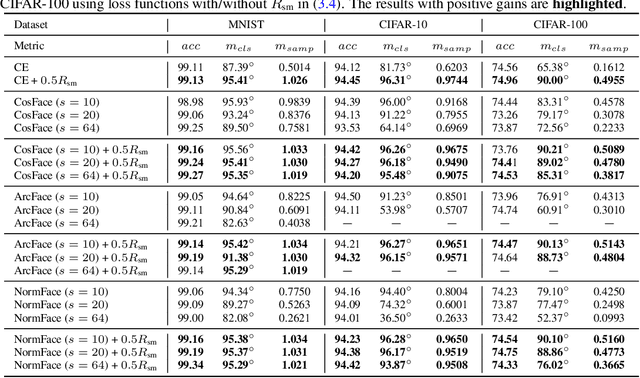

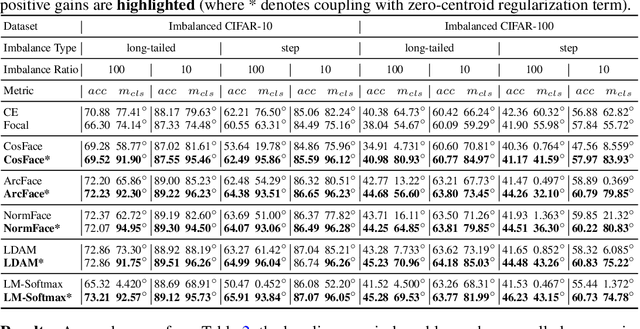
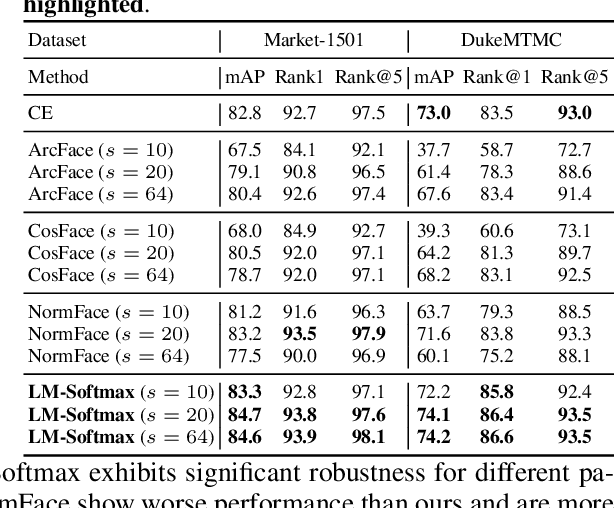
Abstract:One of the main challenges for feature representation in deep learning-based classification is the design of appropriate loss functions that exhibit strong discriminative power. The classical softmax loss does not explicitly encourage discriminative learning of features. A popular direction of research is to incorporate margins in well-established losses in order to enforce extra intra-class compactness and inter-class separability, which, however, were developed through heuristic means, as opposed to rigorous mathematical principles. In this work, we attempt to address this limitation by formulating the principled optimization objective as learning towards the largest margins. Specifically, we firstly define the class margin as the measure of inter-class separability, and the sample margin as the measure of intra-class compactness. Accordingly, to encourage discriminative representation of features, the loss function should promote the largest possible margins for both classes and samples. Furthermore, we derive a generalized margin softmax loss to draw general conclusions for the existing margin-based losses. Not only does this principled framework offer new perspectives to understand and interpret existing margin-based losses, but it also provides new insights that can guide the design of new tools, including sample margin regularization and largest margin softmax loss for the class-balanced case, and zero-centroid regularization for the class-imbalanced case. Experimental results demonstrate the effectiveness of our strategy on a variety of tasks, including visual classification, imbalanced classification, person re-identification, and face verification.
 Add to Chrome
Add to Chrome Add to Firefox
Add to Firefox Add to Edge
Add to Edge